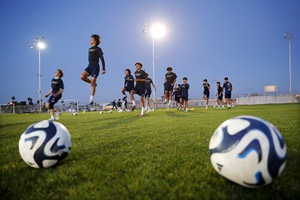It’s 5 a.m. and I’m making the final preparations for a 186-mile relay race across Las Vegas. Over 27 hours, my team of 12 will run from Las Vegas Ski & Snowboard Resort to Lake Las Vegas’ sunny shoreline, each runner hitting the road for three predetermined legs, while a herd of massive white vans follows along, carrying resting teammates and offering cheers, honks and occasional hydration. This year, 461 other teams will join in the wild race adventure that is Ragnar Relay, but for now it’s just me, my backpack and a sense that I’m probably forgetting to pack something. I take a deep breath and grab an extra pair of socks.
Then I check my email. Thousands of miles away in Afghanistan, Capt. Stephen Roberts is already hours into his own race. The Army chaplain has organized Ragnar Relay Afghanistan, an event on the Kabul Base Cluster coinciding with the Vegas race. Five teams of coalition soldiers and a few civilian contractors are taking on the same distances that we’ll run through loops on a 1.05-mile course.
They’re already well on their way, but runners have been dropping like flies, Roberts writes, “due to additional duties, injuries or ailments. With the persistent cold and rain on top of often exhausting workloads (our runners will all be returning to work in between their legs), I could envision another spate of runners going down.”
In Ragnar land, this is a nightmare scenario—fewer bodies covering the mileage meant for 12. But Roberts sees it differently: “With this challenge will come a wonderful opportunity: Many of our runners will be asked to give more than they intended to our effort, and out of duty and loyalty, they will do so.”
When most people talk about Ragnar Relay, they talk about the crazy spirit of the touring race, where many runners take to the course in costumes and decorate their vans with Christmas lights, paint and blowup dolls dressed as Batman. They name their teams after movies (like our Dread Pirate Runners), costumes (Kilty Pleasures) or runner issues (Agony of de Feet), and they scream themselves hoarse cheering on teammates and total strangers. Then they get out on the road and run like hell, three times over about 24 hours, until the whole team crosses the finish line as one. Duty and loyalty don’t come up a lot between the spandex and cowbells, but they’re apt words to describe a race where if one runner goes down someone else must step up until all 186 miles have been run.
In Afghanistan, the race’s wet and chilly start does “nothing to dampen spirits,” Cpl. Will Ross writes. Their Ragnar has coincided with another race on base, a rucksack 5K to honor victims of sexual assault, and the relay runners are dodging and weaving, finishing their legs covered in mud but smiling. “It really does feel great to be a part of something like this,” Ross says.
He’s part of Team Greff, named for Canadian soldier Byron Greff, who was killed on October 29, 2011 in a Taliban attack in Kabul. The team is made up of American and Canadian troops and one civilian contractor, and after three hours and five minutes, they’re on leg 4. There are 36 legs total.
Team Richard’s captain is Canadian Master Cpl. Brian Wiegelt, whom Roberts—an experienced runner himself—calls the “fastest runner by far.” Today, Wiegelt is slated to run 38 of his team’s 186 miles.
In Vegas, we’re moving ahead of schedule, eating up miles faster than we’d expected. Dark settles over the course, and the runners become flashing beacons, blinking their way down city streets past confused cars. The night goes by in spurts. We nap, and snack, and run, and cheer. At one exchange point, runners in sleeping bags are scattered outside a grade school like small, breathing speed bumps; at another, someone’s set up a row of tiny hurdles for incoming runners to jump over or ignore. As I wait to start my final leg, teams toast marshmallows over a small campfire next to an empty bounce house. When I hand off the slap bracelet three miles later, I’m all smiles and sore legs, relieved yet sad to be done.
In Afghanistan, Roberts is called off on an assignment, missing the finish line fun for work that needs to be done. Reflecting on the race later, he writes, “Most of our runners, though fit, were utterly unprepared for this type of event. We expected that. We also expected that they would persevere, and we were not disappointed.”
Struggling is part of Ragnar, whether it’s with a mighty hill or extra miles, on base or in the Vegas desert.
“I saw one Canadian team captain, forced into ultra-type mileage, sitting upright in his chair at the start line, sleeping in a sleeping bag,” Roberts writes. “I'm not sure he ever left that place during the night.”
Duty and loyalty. Roberts saw them in that Canadian runner. I saw them in race volunteers who worked enthusiastically in the dark, in crews whooping it up for total strangers, in my Van 2 teammates who stopped twice to help lost runners from other teams get back on course.
Ragnar has a way of bringing out the best in people—no matter where they’re running.







